How many years have you been working 100% remotely?
Source: Remote Work Report
Remote work is growing. And fast. It’s been estimated that by 2025, 70% of the workforce will work remotely at least five days in a month.
And that was before coronavirus forced most of us to start working remotely.
Large and small companies were already adopting remote work. Whether it’s flexible work with a few days of work from home, or full-on remote work without an office, it’s growing.
To understand the state of remote work around the world, we dove into data from We Work Remotely (WWR), the largest remote work community in the world.
WWR is a job board where companies can post fully remote roles
We analyzed over 11,000 jobs posted on WWR over the course of 6 years to understand everything we could about the changing landscape of remote work.
At Nira, we’ve become experts at remote work, and not just because we’re a remote company ourselves.
We’ve surveyed thousands of people about remote work over the years. Including how people feel about it (hint: they love it). What people’s tips and best practices are for working remotely. And we even dug into all the remote work stats.
Even so, we didn’t expect the trends that we found in the WWR job postings.
Remote work is a force to be reckoned with. Yet remote work hasn’t been adopted equally across the world. It’s still rare in many countries.
Currently, most fully-remote jobs come from companies based in English-speaking countries.
In this report, we deep dive into everything we learned analyzing We Work Remotely’s data. Plus, we’ll share insights and trends about where we see remote work heading in the future.
Remote work has been growing each year, with people increasingly having the opportunity to work from home, or wherever they’d like.
The opportunity to work remotely and have flexibility are becoming expectations for job seekers.
Companies want to meet these expectations by offering more flexible work practices. From 2016 to 2018, the number of job posts on LinkedIn mentioning work flexibility rose by over 78%.
Over half of US companies offer remote work to their employees to increase retention. That’s because flexible work is a major consideration for over three quarters (77%) of employees when they evaluate job opportunities. The lack of flexibility can lead to employee attrition, with 62% of people leaving or considering leaving jobs because they didn’t have enough flexibility.
Remote work isn't something new, it has been growing for years.
In fact, most fully-remote workers are veterans of remote work.
Seventy percent of fully-remote workers say they’ve worked remotely for 3 or more years. Forty-two percent say they’ve worked remotely for 5 or more years.
Source: Remote Work Report
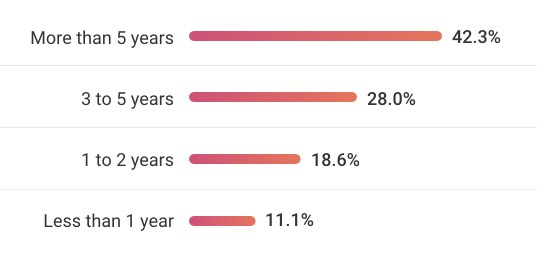
WWR has seen consistent year-over-year growth in remote jobs, with the number of jobs posted growing by an average of 30% from 2014 to 2019. Climbing from 848 jobs in 2014 to 3144 in 2019.

Remote work isn’t just growing with the usual departments either. Although engineering roles continue to be the most commonly posted remote roles, more types of roles are going remote too.
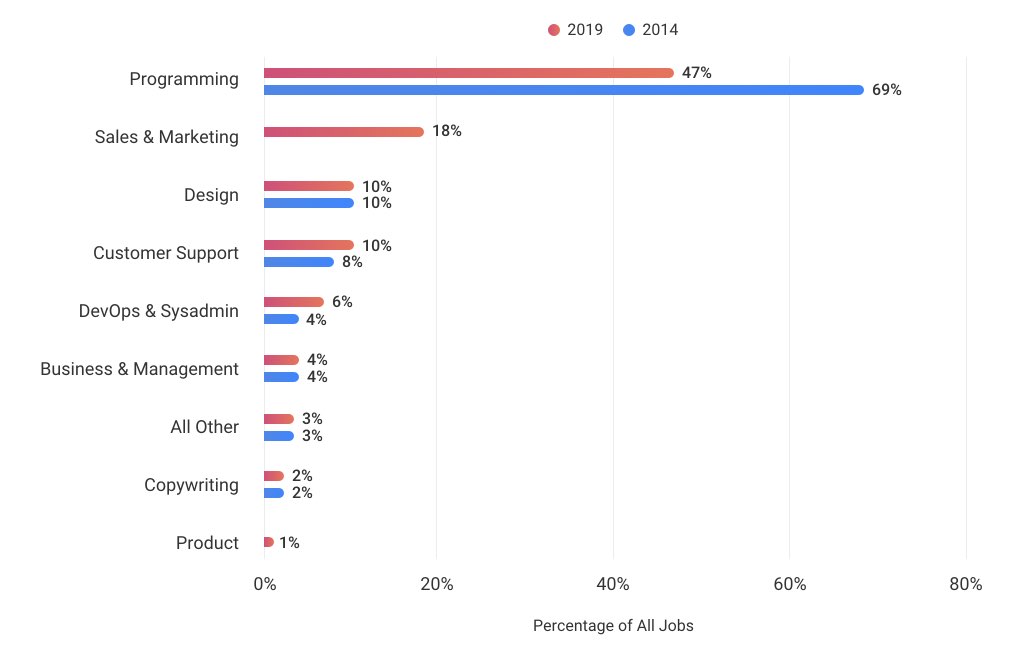
Back in 2014, 69% of remote roles posted on WWR were engineering roles. The next largest remote roles were design (10%) and customer support (8%).
Sales and Marketing roles weren’t even a job-posting category on WWR until 2015, and Product wasn’t a category until 2018, since the demand for these types of roles was so low.
Last year, engineering roles were still the top-posted roles on WWR, with programming jobs making up 47% of posted roles in 2019. But Sales & Marketing became the next largest remote role category at 18%, followed by design and customer support, each at 10%. A few years ago, Sales & Marketing wasn’t even a category, and now it’s the second-largest role category.
Product is small at 1% but it’s growing.
Hiring for remote jobs takes a certain amount of bravery.
If you have an office, hiring remote team members means you’ll have some people in an office, and others off on their own at home, in coworking spaces or coffee shops. You’ll feel like you have less visibility into what they’re doing since you can’t tap them on the shoulder or walk up to them in the office.
And if you don’t have an office, you’ll need to manage everyone from afar, bringing the team together through video calls and via collaboration software. You might not even meet the new team members you hire in person for a year or more.
So what types of companies are hiring fully remote roles?
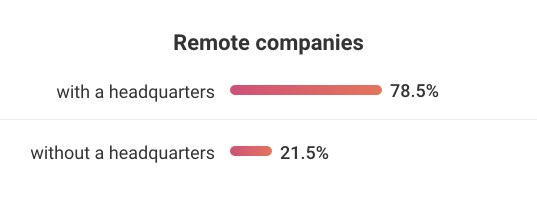
The majority of companies hiring remote roles - 78.5% - have at least one office.
But one in five remote companies doesn’t have a company headquarters at all.
Instead, when asked by WWR where their company headquarters is located, these companies use terms to describe their homebase like:
Of the 3,144 remote roles posted on WWR in 2019, 2,468 came from semi-remote companies who had an office somewhere in the world, and 676 came from fully-remote companies.
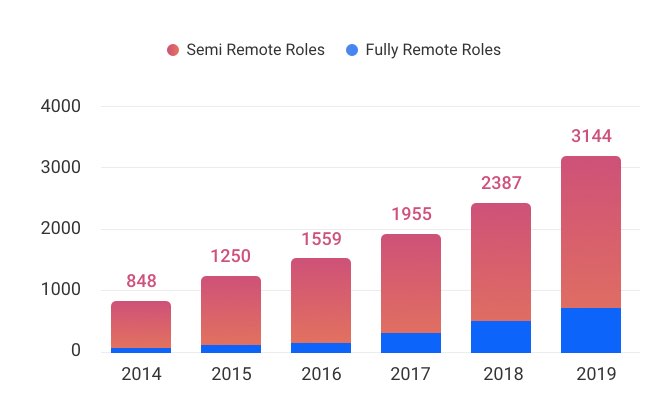
Roles posted by fully-remote companies grew by 973% between 2014 and 2019. While semi-remote grew by 214% in the same period.
Companies hiring remote workers tend to be on the smaller side.
Over 90% of roles posted on WWR in 2019 came from companies that had 250 or fewer people.
Only 7% of roles were posted by companies with 251 to one thousand people, and 1% from companies with over one thousand people.
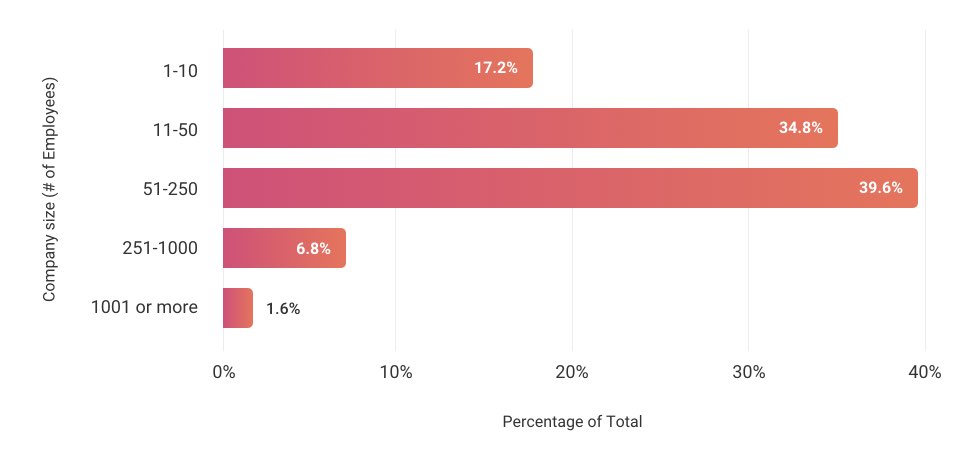
Smaller companies are more likely to have a higher percentage of remote workers.
That’s because larger companies have been slower to adopt remote work.
They’re more likely to have offices where employees are expected to come in daily, and are less used to using software that enables remote collaboration.
Although companies that hire remote workers tend to be on the smaller side, there are larger companies that have embraced either fully-remote work or work from home a few days a week.
For example, almost 60% of Dell’s employees work flexibly, and also happen to have a Net Promoter Score that is 20% higher than those that don’t work remotely.
Two thousand of Aetna’s 35,000 employees work from home at least a few days a week. And Best Buy saw increased productivity with departments that were allowed to work from wherever they wanted, whenever they wanted.
The United States takes the gold when it comes to which countries are hiring the most fully-remote workers.
The US is the top country hiring fully-remote workers on WWR, with 56.3% of all roles on WWR.
This lines up with data from Owl Labs, which showed that a whopping 85% of US companies were partially or fully remote. That’s 29% higher than the global average of 56%.
The UK is the next top hirer on WWR, with 6.1% of roles coming from companies headquartered in the UK. Followed by Canada (4.0%), Australia (3.1%) and Germany (1.7%).
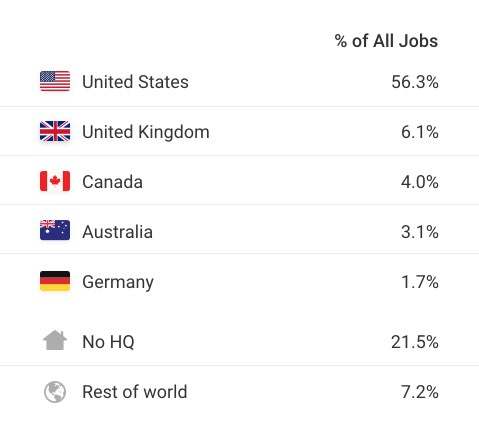
English speaking countries are hiring more fully-remote roles than the rest of the world.
71% of WWR roles come from English-speaking countries
Seventy-one percent of companies who posted a remote job ad on WWR in 2019 were headquartered in English-speaking countries.
Only 7.4% of fully-remote roles came from companies based in non-English speaking countries. Including Germany, Estonia, France, Switzerland, Spain, Russia, and more.

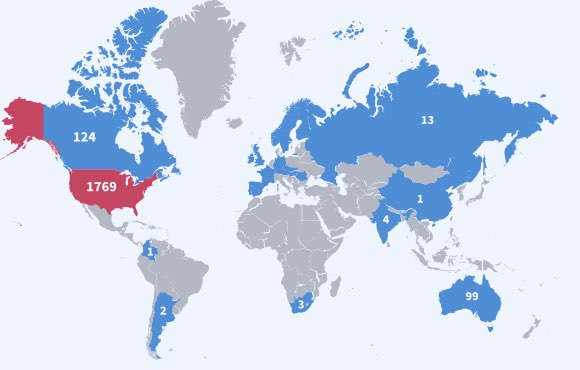
Surprisingly, fewer than 1% of roles posted on WWR came from companies headquartered in Asia and South America.
While the high percentage of fully-remote roles in English speaking countries could be attributed to the fact that WWR is a Canadian company and the website is only available in English, WWR’s data is largely consistent with other sources.
When workers were asked if their organizations offered remote working some or all of the time, Australia was the top country (45%), followed by the US (43%).
Source: The Modern Workplace Report
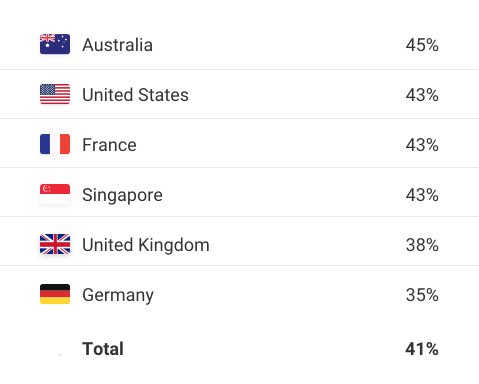
OWLLabs polled over 3,000 employees worldwide and found that Asia and South America have 9% more companies that don’t allow remote work than the global average.
And of countries that have flexible work policies, China (51%) and Japan (32%) had the lowest percentages, compared to the global average of 62%.
Source: IWG Global Workplace Survey, 2019
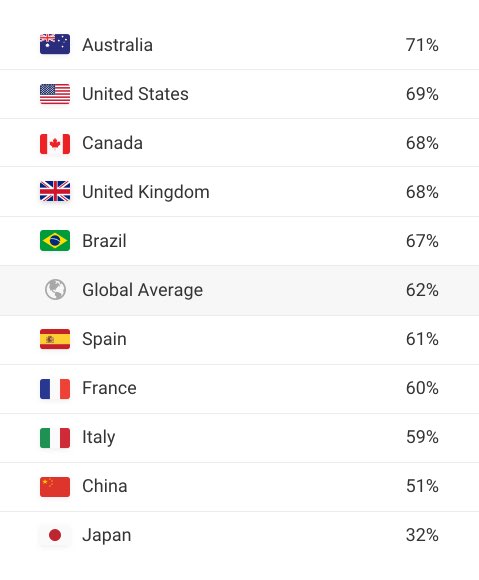
So what are the cities hiring the most remote workers?
The top city hiring remote workers was - no surprise - San Francisco.
San Francisco-based companies were responsible for 7% of all roles posted on WWR in 2019.
The second-largest remote hiring city was New York (6%), followed by London (4%), Austin (2%) and Los Angeles (2%).
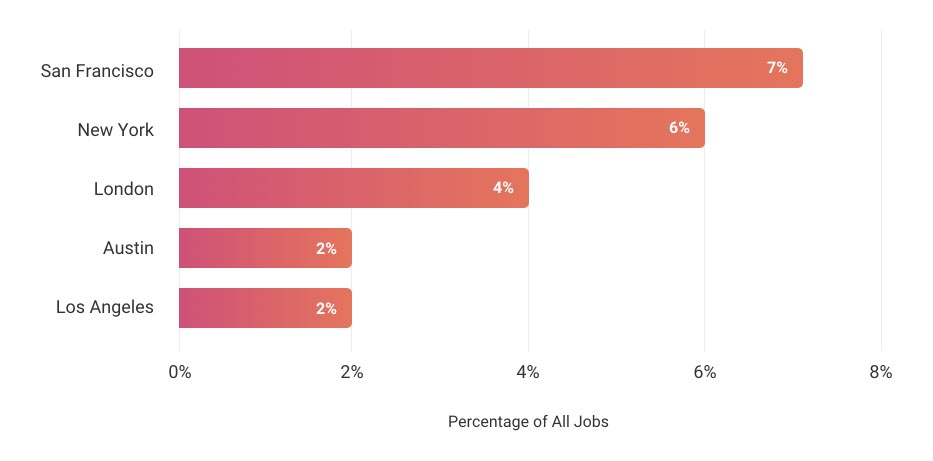
There are a few possible reasons for why these cities have the most remote jobs:
What about the locations of remote workers?
Companies hiring remote roles are able to specify where they want their employees to be based.
This is typically because companies have preferred time zones for everyone.
Of all the roles posted on WWR in 2019, 63% of them had location restrictions.
The rest - 37% - had no location restrictions and accepted applicants from anywhere in the world.
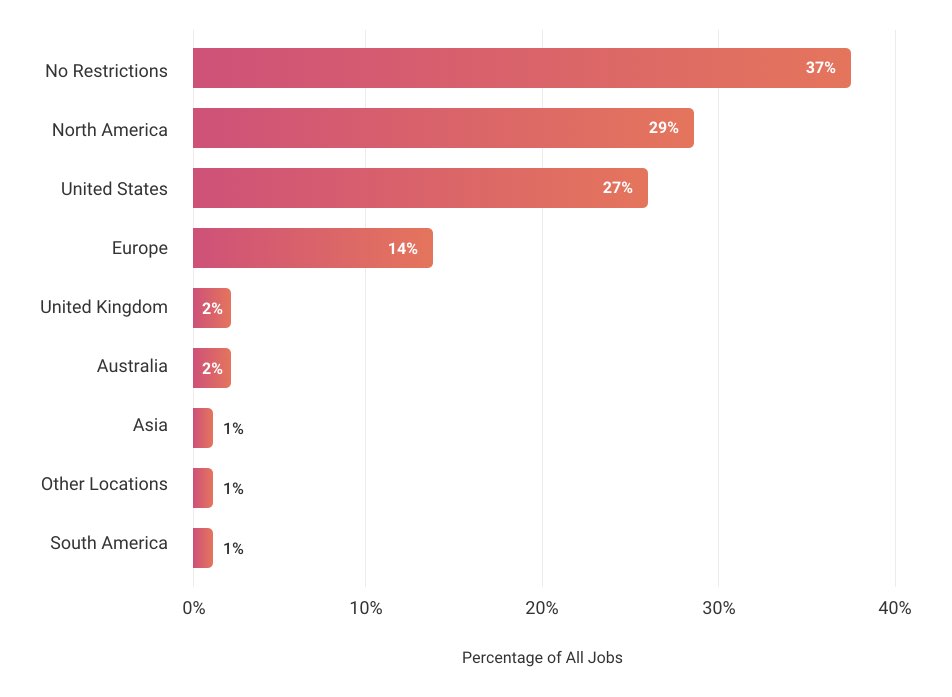
Note: Employers were able to select one or multiple location restrictions.
For applicants working in any US time zone, location restrictions meant that they were able to apply to almost any jobs. Those in Europe were able to apply to 50% of jobs.
For people applying from Asia and South America, about 60% of roles were out of reach. These folks are currently limited primarily to companies offering true “work anywhere” roles.
A 2017 study by Academia Internacional de Teletrabajo showed that about 10% of the workforce in Brazil and Argentina work remotely, while only 5-6% work remotely in Chile and Mexico.
That’s significantly lower than in the US, where 54% of the total workforce worked remotely in some capacity in 2016, and 20% worked remotely full time. In the European Union only 10% of people worked remotely in some capacity.
While flexible work is prevalent in many parts of the world, when it comes to fully-remote roles, English speaking countries are leading.
We’ve gathered 17 tips from remote workers to help you with recruiting a distributed team. Here are a few of the top tips and you can view them all too.
Even before coronavirus hit, all signs pointed to an even faster growth trajectory for remote work. Remote work is likely to spread not just in the US and English speaking countries, but also in countries where remote work has had less penetration.
The barriers that held companies back from remote work were already crashing down.
People have been getting used to collaboration apps like Zoom, Google Hangouts, Slack, and Microsoft Teams. These apps are making it so much easier to work remotely and communicate from afar.
This pace will only accelerate now that many of us have been forced to work remotely because of coronavirus.
We suspect that once people have a taste of remote work, they’ll want more.
That’s because people who work remotely almost all love remote work.
People who get used to working remotely often can’t envision going back. Over half of employees at small businesses said they’d prefer taking a pay cut rather than being restricted to working in an office.
What happens once a large number of people who never worked remotely experience remote work, and actually like it?
Before coronavirus forced so many people to work from home, over half of people who worked for companies that didn’t have remote-work policies said they felt frustrated and wished they could work from home.
Will even more people be frustrated? Will there be new expectations for flexibility? And will people be more likely to leave their employers in favor of companies that do offer those benefits?
Our hunch is yes. Employers will need to step up and offer more flexible work options to retain talent after coronavirus restrictions are relaxed.
The pull to remote work won’t just come from the employees themselves. Another huge benefit of remote work is productivity.
Remote workers are actually more productive than those who work in offices, reporting that they get more work done.
A study conducted by travel agency Ctrip showed that its work from home employees experienced a 13% performance increase as a result of working for longer, taking fewer breaks, having fewer sick days, and having a quieter and more convenient working environment.
The state of Utah also ran a remote work pilot across four state agencies and saw a 23% productivity increase.
Though the conditions of remote work during coronavirus are atypical, people and companies are bound to see improved productivity. No more interruptions. No more water-cooler chat or long lunches.
Why would companies want to go back?
With so many companies across the world forced into instituting remote work policies and processes, the transition to remote work in the future will be that much easier. Even if people are able to go back to work within the next few weeks, the effects on the way people work will be felt for years to come.
Remote has a special place in our hearts at Nira. We’re a fully remote team with folks based all over the world. We love working remotely! And we love helping our team (plus everyone else!) have a better experience with remote work. Nira is a product that helps any team - remote, distributed or in an office - find information across the company, faster.
A huge thank you to We Work Remotely, who provided us with the data. We are happy customers of We Work Remotely and think the world is a better place thanks to them ❤️.